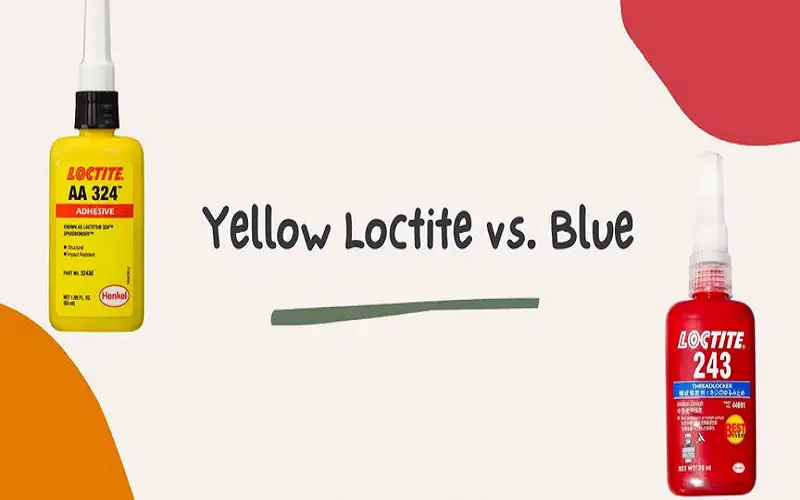Yellow Loctite is designed for low-strength applications, while Blue Loctite is for medium-strength. When choosing between Yellow and Blue Loctite for your project, understanding the specific needs and requirements is crucial.
Yellow Loctite is ideal for securing screws, nuts, and bolts that need to be removed easily, while Blue Loctite offers more secure, semi-permanent locking. Both options are designed to prevent loosening due to vibration and can withstand various environmental conditions.
It’s important to carefully assess the level of strength and permanence required for your specific application in order to choose the most suitable Loctite product. By understanding the differences and applications of Yellow and Blue Loctite, you can ensure the success and longevity of your project.
Contents
Yellow Loctite
When it comes to securing bolts, nuts, and threads, choosing the right adhesive can make all the difference. Yellow Loctite is a popular choice among mechanics and DIY enthusiasts due to its versatile properties and wide range of applications.
Features And Properties
Yellow Loctite, also known as medium-strength threadlocker, is a anaerobic adhesive that cures when confined in the absence of air. Its viscosity allows it to flow into the gaps between threaded parts, providing a strong and durable bond.
- Medium-strength: Ideal for fasteners that need to be disassembled with hand tools.
- Oil-resistant: Can withstand exposure to lubricants and most industrial fluids.
- Temperature resistance: Withstands temperatures up to 300°F (150°C).
- Curing time: Sets in 10 to 20 minutes, with full cure in 24 hours.
Ideal Applications
Yellow Loctite is suitable for a wide array of applications, including:
- Machinery and equipment assembly
- Automotive repairs
- Electrical and industrial equipment
- Plumbing installations
- General maintenance and repairs

Blue Loctite
Blue Loctite is a reliable option for securing threaded fasteners, offering strong resistance to loosening. Compared to its yellow counterpart, Blue Loctite provides a more secure hold and is ideal for applications that require medium strength.
Blue Loctite is a type of threadlocker known for its medium strength and versatility. It is designed to prevent fasteners from loosening due to vibration or shock.
Blue Loctite offers various features and properties that make it a popular choice for a wide range of applications.
Features And Properties
Ideal Applications
- Automotive repairs
- Small appliance assembly
- Electrical component installation
- General household maintenance Its medium strength and removal capabilities make it ideal for applications where disassembly may be required in the future.
Difference In Strength
The difference in strength between yellow and blue threadlockers plays a vital role in determining their suitability for different types of fasteners. Understanding this difference can help you choose the right threadlocker for your specific application.
In this article, we will examine and compare the strength of yellow and blue threadlockers, as well as their effect on different types of fasteners.
Comparing The Strength Of Yellow And Blue Threadlockers
When it comes to threadlocking applications, the strength of the threadlocker is a crucial factor.
Yellow and blue threadlockers exhibit different levels of strength, as indicated by their color codes. Here’s a comparison between the two:
| Threadlocker | Strength |
|---|---|
| Yellow Loctite | Medium strength |
| Blue Loctite | Medium to high strength |
Yellow Loctite, also known as Loctite 242, offers a reliable medium-level strength suitable for a wide range of applications. It provides enough resistance to prevent screws, nuts, or bolts from loosening due to vibrations or other external factors.
On the other hand, Blue Loctite, or Loctite 243, offers a step up in strength. It provides a medium to high strength level, making it ideal for applications that require more robust threadlocking, especially for fasteners that may be exposed to high levels of vibration or stress.
Effect On Different Types Of Fasteners
When choosing between yellow and blue threadlockers, it’s essential to consider the effect they have on various types of fasteners:
- Yellow Loctite is suitable for fasteners made of metals, including steel, aluminum, and brass. It provides a secure grip while still allowing for disassembly with standard hand tools.
- Blue Loctite, with its higher strength level, is recommended for fasteners subjected to heavy-duty applications. It is particularly advantageous for securing fasteners that are prone to loosening, such as those used in automotive or machinery industries.
It’s important to note that both yellow and blue Loctite require some curing time to reach their full strength. While yellow threadlocker typically achieves its optimum strength within 24 hours, blue threadlocker may take up to 72 hours to fully cure.
In conclusion, the difference in strength between yellow and blue threadlockers is significant. While both can provide reliable threadlocking capabilities, the choice depends on the specific application and the type of fasteners being used.
Application Process
Learn about the application process for Yellow and Blue Loctite to ensure optimal usage and bonding effectiveness.
Differentiate between the two options to make informed decisions when securing various materials. Understand the nuances of each Loctite type for successful applications in your projects.
How To Apply Yellow Loctite?
Applying yellow Loctite is a straightforward process that requires a few simple steps. Follow this step-by-step guide to ensure proper application:
1. Prepare the surfaces: Clean the surfaces to be bonded thoroughly using a suitable solvent. Ensure that they are free from grease, oil, dust, and debris.
2. Apply the adhesive: Squeeze a small amount of yellow Loctite onto one of the surfaces. A light and uniform coating is usually sufficient.
3. Assemble the parts: Join the surfaces together immediately after applying the adhesive. Apply sufficient pressure for a few seconds to ensure proper contact and bonding.
4. Cure the adhesive: Leave the assembly undisturbed for the recommended curing time. This allows the adhesive to fully cure and achieve its maximum strength.
5. Check for excess adhesive: Carefully wipe off any excess adhesive that may have squeezed out during the assembly process.
6. Let it cure completely: Allow the adhesive to cure completely before subjecting the bonded parts to any load or stress.
Refer to the manufacturer’s instructions for the recommended curing time. Remember to wear gloves to protect your hands during the application process. It is also recommended to work in a well-ventilated area for better safety.
How To Apply Blue Loctite?
Applying blue Loctite is similar to applying yellow Loctite, but with a slightly different process. Here’s how you can apply blue Loctite effectively:
1. Clean the surfaces: Ensure that the surfaces you want to bond are clean and free from any contaminants like oil, grease, and dirt. Clean them thoroughly using a suitable solvent.
2. Apply the adhesive: Apply a small amount of blue Loctite directly onto one of the surfaces to be bonded. Apply the adhesive sparingly for optimal results.
3. Assemble the parts: Immediately join the surfaces together after applying the adhesive. Apply sufficient pressure to ensure proper contact between the surfaces.
4. Cure the adhesive: Allow the assembly to sit undisturbed for the recommended curing time. This time allows the adhesive to fully cure and reach its maximum strength.
5. Remove excess adhesive: If any excess adhesive squeezes out during the assembly process, carefully remove it using a clean, lint-free cloth or applicator.
6. Complete the curing process: Allow the adhesive to cure completely before subjecting the bonded parts to any loads or stresses. Refer to the manufacturer’s instructions for the specific curing time.
Always follow the manufacturer’s instructions for application, as different products may have specific requirements. As with yellow Loctite, it is essential to work in a well-ventilated area and wear gloves for safety during the application process.
Remember, proper application is key to achieving strong and reliable bonds with both yellow and blue Loctite adhesive options.
Drying And Curing Time
Duration For Yellow Loctite To Dry And Cure
Yellow Loctite typically takes 15 minutes to dry and 24 hours to cure fully.
Duration For Blue Loctite To Dry And Cure
Blue Loctite dries within 10 minutes and cures completely in 24 hours.

Removability
When considering the factors that set Yellow Loctite and Blue Loctite apart, the removability of fasteners plays a pivotal role.
Evaluating the ease of undoing fasteners secured with each type of Loctite can provide valuable insights into their practical applications.
Ease Of Removing Fasteners Secured With Yellow Loctite
The yellow-colored Loctite is designed to provide medium-strength bonding and is often ideal for securing fasteners that may need to be removed in the future.
When it comes to undoing fasteners secured with yellow Loctite, the process can be relatively straightforward. With the application of the appropriate tools and techniques, fasteners treated with yellow Loctite can be removed without excessive difficulty.
Ease Of Removing Fasteners Secured With Blue Loctite
On the other hand, fasteners secured with blue-colored Loctite are intended for providing a stronger, more permanent bond. Consequently, the removal of fasteners secured with blue Loctite may require more effort and specific tools to break the bond.
Undoing fasteners treated with blue Loctite can be a more involved process compared to those treated with yellow Loctite, demanding meticulous attention and precision to prevent damage to the fasteners.
Best Practices
When using Yellow and Blue Loctite, following best practices can help ensure optimal results.
Tips For Using Yellow And Blue Loctite Effectively
- For stronger bonding, use Yellow Loctite on threads larger than 3/4 inch.
- Use Blue Loctite for threads smaller than 3/4 inch for secure fittings.
Precautions And Recommendations
- Avoid over-applying Yellow Loctite as it may lead to excess leakage.
- Store Blue Loctite in a cool, dry place to maintain its effectiveness.
Frequently Asked Questions For Yellow Loctite Vs Blue
What Is Yellow Loctite?
Yellow Loctite is a type of adhesive used to secure fasteners. It is a threadlocker that comes in a liquid form and cures to prevent screws and bolts from loosening due to vibration. This helps to maintain the integrity of the assembly and prevent potential damage.
What Is The Difference Between The Colors Of Loctite?
The different colors of Loctite indicate the specific formula and purpose. For instance, red is for permanent bonding, blue is for removable strength, and green is for threadlocking. Each color serves a different purpose in adhesive and sealing applications.
What Colour Loctite Is Strongest?
The red Loctite is the strongest color for permanent bonding applications due to its high strength formula.
What Is Blue Loctite Used For?
Blue Loctite is a type of adhesive used for securing threaded fasteners. It provides a strong, secure bond, preventing them from loosening due to vibrations or other factors. It is commonly used in automotive, construction, and industrial applications.
Conclusion
The choice between Yellow Loctite and Blue Loctite depends on the specific needs of your project. Yellow Loctite offers a permanent bond while Blue Loctite allows for disassembly.
Consider the level of strength and durability required for your application. By understanding the characteristics of these two adhesives, you can make an informed decision and ensure the success of your project.

